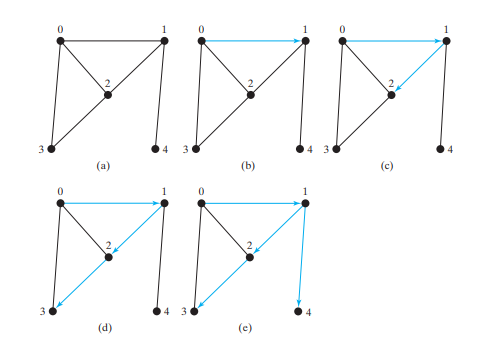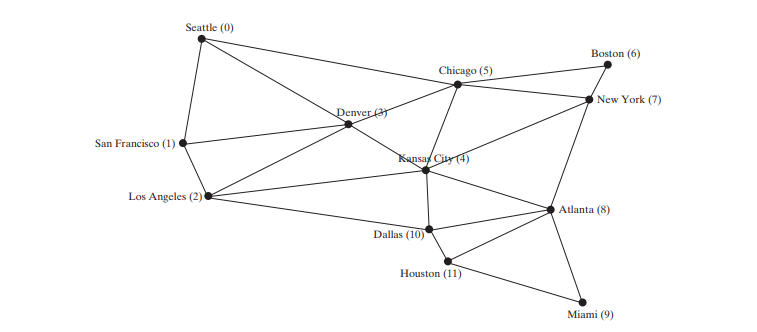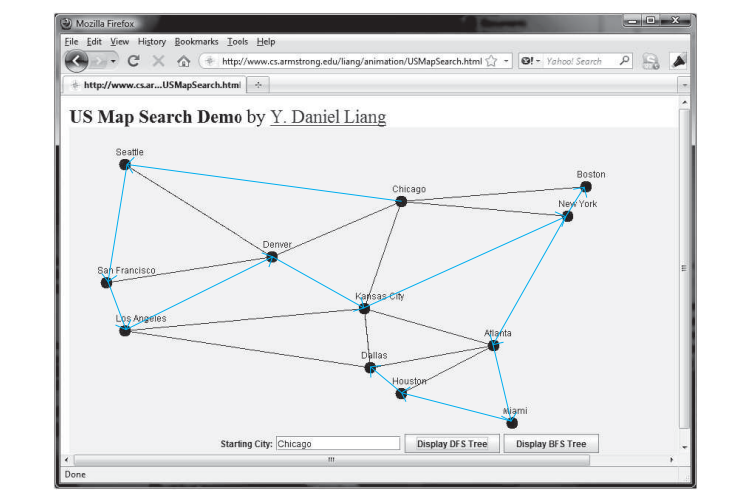Depth-First Search (DFS)
The depth-first search of a graph starts from a vertex in the graph and visits all vertices in the graph as far as possible before backtracking.
The depth-first search of a graph is like the depth-first search of a tree discussed in Tree Traversal, Tree Traversal. In the case of a tree, the search starts from the root. In a graph, the search can start from any vertex.
A depth-first search of a tree first visits the root, then recursively visits the subtrees of the root. Similarly, the depth-first search of a graph first visits a vertex, then it recursively visits all the vertices adjacent to that vertex. The difference is that the graph may contain cycles, which could lead to an infinite recursion. To avoid this problem, you need to track the vertices that have already been visited.
The search is called depth-first because it searches “deeper” in the graph as much as possible. The search starts from some vertex v. After visiting v, it visits an unvisited neighbor of v. If v has no unvisited neighbor, the search backtracks to the vertex from which it reached v. We assume that the graph is connected and the search starting from any vertex can reach all the vertices.
Depth-First Search Algorithm
The algorithm for the depth-first search is described in the code below.
Input: G = (V, E) and a starting vertex v
Output: a DFS tree rooted at v
1 Tree dfs(vertex v) {
2 visit v;
3 for each neighbor w of v
4 if (w has not been visited) {
5 set v as the parent for w in the tree;
6 dfs(w);
7 }
8 }
You can use an array named isVisited to denote whether a vertex has been visited. Initially, isVisited[i] is false for each vertex i. Once a vertex, say v, is visited, isVisited[v] is set to true.
Consider the graph in Figure below (a). Suppose we start the depth-first search from vertex 0. First visit 0, then any of its neighbors, say 1. Now 1 is visited, as shown in Figure below (b). Vertex 1 has three neighbors—0, 2, and 4. Since 0 has already been visited, you will visit either 2 or 4. Let us pick 2. Now 2 is visited, as shown in Figure below (c). Vertex 2 has three neighbors: 0, 1, and 3. Since 0 and 1 have already been visited, pick 3. 3 is now visited, as shown in Figure below (d). At this point, the vertices have been visited in this order:
0, 1, 2, 3
Since all the neighbors of 3 have been visited, backtrack to 2. Since all the vertices of 2 have been visited, backtrack to 1. 4 is adjacent to 1, but 4 has not been visited. Therefore, visit 4, as shown in Figure below (e). Since all the neighbors of 4 have been visited, backtrack to 1.
Since all the neighbors of 1 have been visited, backtrack to 0. Since all the neighbors of 0 have been visited, the search ends.

Since each edge and each vertex is visited only once, the time complexity of the dfs method is O(|E| |V|), where |E| denotes the number of edges and |V| the number of vertices.
Implementation of Depth-First Search
The algorithm for DFS in the code above uses recursion. It is natural to use recursion to implement it. Alternatively, you can use a stack.
The dfs(int v) method is implemented in lines 164–193 in AbstractGraph.java. It returns an instance of the Tree class with vertex v as the root. The method stores the vertices searched in the list searchOrder (line 165), the parent of each vertex in the array parent (line 166), and uses the isVisited array to indicate whether a vertex has been visited (line 171). It invokes the helper method dfs(v, parent, searchOrder, isVisited) to perform a depth-first search (line 174).
In the recursive helper method, the search starts from vertex u. u is added to searchOrder in line 184 and is marked as visited (line 185). For each unvisited neighbor of u, the method is recursively invoked to perform a depth-first search. When a vertex e.v is visited, the parent of e.v is stored in parent[e.v] (line 189). The method returns when all vertices are visited for a connected graph, or in a connected component.

The code below gives a test program that displays a DFS for the graph in Figure above starting from Chicago. The graphical illustration of the DFS starting from Chicago is shown in Figure below.
public class TestDFS {
public static void main(String[] args) {
String[] vertices = {"Seattle", "San Francisco", "Los Angeles", "Denver", "Kansas City", "Chicago", "Boston", "New York", "Atlanta", "Miami", "Dallas", "Houston"};
int[][] edges = {
{0, 1}, {0, 3}, {0, 5},
{1, 0}, {1, 2}, {1, 3},
{2, 1}, {2, 3}, {2, 4}, {2, 10},
{3, 0}, {3, 1}, {3, 2}, {3, 4}, {3, 5},
{4, 2}, {4, 3}, {4, 5}, {4, 7}, {4, 8}, {4, 10},
{5, 0}, {5, 3}, {5, 4}, {5, 6}, {5, 7},
{6, 5}, {6, 7},
{7, 4}, {7, 5}, {7, 6}, {7, 8},
{8, 4}, {8, 7}, {8, 9}, {8, 10}, {8, 11},
{9, 8}, {9, 11},
{10, 2}, {10, 4}, {10, 8}, {10, 11},
{11, 8}, {11, 9}, {11, 10}
};
Graph graph = new UnweightedGraph(vertices, edges);
AbstractGraph.Tree dfs = graph.dfs(graph.getIndex("Chicago"));
java.util.List searchOrders = dfs.getSearchOrder();
System.out.println(dfs.getNumberOfVerticesFound() " vertices are searched in this DFS order:");
for(int i = 0; i
12 vertices are searched in this DFS order:
Chicago Seattle San Francisco Los Angeles Denver
Kansas City New York Boston Atlanta Miami Houston Dallas
parent of Seattle is Chicago
parent of San Francisco is Seattle
parent of Los Angeles is San Francisco
parent of Denver is Los Angeles
parent of Kansas City is Denver
parent of Boston is New York
parent of New York is Kansas City
parent of Atlanta is New York
parent of Miami is Atlanta
parent of Dallas is Houston
parent of Houston is Miami

Applications of the DFS
The depth-first search can be used to solve many problems, such as the following:
- Detecting whether a graph is connected. Search the graph starting from any vertex. If the number of vertices searched is the same as the number of vertices in the graph, the graph is connected. Otherwise, the graph is not connected.
- Detecting whether there is a path between two vertices.
- Finding a path between two vertices.
- Finding all connected components. A connected component is a maximal connected subgraph in which every pair of vertices are connected by a path.
- Detecting whether there is a cycle in the graph.
- Finding a cycle in the graph.
- Finding a Hamiltonian path/cycle. A Hamiltonian path in a graph is a path that visits each vertex in the graph exactly once. A Hamiltonian cycle visits each vertex in the graph exactly once and returns to the starting vertex.
The first six problems can be easily solved using the dfs method in AbstractGraph.java. To find a Hamiltonian path/cycle, you have to explore all possible DFSs to find the one that leads to the longest path. The Hamiltonian path/cycle has many applications, including for solving the well-known Knight’s Tour problem.
-
 How Can I Synchronously Iterate and Print Values from Two Equal-Sized Arrays in PHP?Synchronously Iterating and Printing Values from Two Arrays of the Same SizeWhen creating a selectbox using two arrays of equal size, one containing c...Programming Posted on 2025-04-05
How Can I Synchronously Iterate and Print Values from Two Equal-Sized Arrays in PHP?Synchronously Iterating and Printing Values from Two Arrays of the Same SizeWhen creating a selectbox using two arrays of equal size, one containing c...Programming Posted on 2025-04-05 -
 How Can I Execute Multiple SQL Statements in a Single Query Using Node-MySQL?Multi-Statement Query Support in Node-MySQLIn Node.js, the question arises when executing multiple SQL statements in a single query using the node-mys...Programming Posted on 2025-04-05
How Can I Execute Multiple SQL Statements in a Single Query Using Node-MySQL?Multi-Statement Query Support in Node-MySQLIn Node.js, the question arises when executing multiple SQL statements in a single query using the node-mys...Programming Posted on 2025-04-05 -
 Why Am I Getting a "Could Not Find an Implementation of the Query Pattern" Error in My Silverlight LINQ Query?Query Pattern Implementation Absence: Resolving "Could Not Find" ErrorsIn a Silverlight application, an attempt to establish a database conn...Programming Posted on 2025-04-05
Why Am I Getting a "Could Not Find an Implementation of the Query Pattern" Error in My Silverlight LINQ Query?Query Pattern Implementation Absence: Resolving "Could Not Find" ErrorsIn a Silverlight application, an attempt to establish a database conn...Programming Posted on 2025-04-05 -
 How to Bypass Website Blocks with Python's Requests and Fake User Agents?How to Simulate Browser Behavior with Python's Requests and Fake User AgentsPython's Requests library is a powerful tool for making HTTP reque...Programming Posted on 2025-04-05
How to Bypass Website Blocks with Python's Requests and Fake User Agents?How to Simulate Browser Behavior with Python's Requests and Fake User AgentsPython's Requests library is a powerful tool for making HTTP reque...Programming Posted on 2025-04-05 -
 How to Parse Numbers in Exponential Notation Using Decimal.Parse()?Parsing a Number from Exponential NotationWhen attempting to parse a string expressed in exponential notation using Decimal.Parse("1.2345E-02&quo...Programming Posted on 2025-04-05
How to Parse Numbers in Exponential Notation Using Decimal.Parse()?Parsing a Number from Exponential NotationWhen attempting to parse a string expressed in exponential notation using Decimal.Parse("1.2345E-02&quo...Programming Posted on 2025-04-05 -
 How to Resolve \"Refused to Load Script...\" Errors Due to Android\'s Content Security Policy?Unveiling the Mystery: Content Security Policy Directive ErrorsEncountering the enigmatic error "Refused to load the script..." when deployi...Programming Posted on 2025-04-05
How to Resolve \"Refused to Load Script...\" Errors Due to Android\'s Content Security Policy?Unveiling the Mystery: Content Security Policy Directive ErrorsEncountering the enigmatic error "Refused to load the script..." when deployi...Programming Posted on 2025-04-05 -
 Is There a Performance Difference Between Using a For-Each Loop and an Iterator for Collection Traversal in Java?For Each Loop vs. Iterator: Efficiency in Collection TraversalIntroductionWhen traversing a collection in Java, the choice arises between using a for-...Programming Posted on 2025-04-05
Is There a Performance Difference Between Using a For-Each Loop and an Iterator for Collection Traversal in Java?For Each Loop vs. Iterator: Efficiency in Collection TraversalIntroductionWhen traversing a collection in Java, the choice arises between using a for-...Programming Posted on 2025-04-05 -
 How to Create a Smooth Left-Right CSS Animation for a Div Within Its Container?Generic CSS Animation for Left-Right MovementIn this article, we'll explore creating a generic CSS animation to move a div left and right, reachin...Programming Posted on 2025-04-05
How to Create a Smooth Left-Right CSS Animation for a Div Within Its Container?Generic CSS Animation for Left-Right MovementIn this article, we'll explore creating a generic CSS animation to move a div left and right, reachin...Programming Posted on 2025-04-05 -
 How to Implement a Generic Hash Function for Tuples in Unordered Collections?Generic Hash Function for Tuples in Unordered CollectionsThe std::unordered_map and std::unordered_set containers provide efficient lookup and inserti...Programming Posted on 2025-04-05
How to Implement a Generic Hash Function for Tuples in Unordered Collections?Generic Hash Function for Tuples in Unordered CollectionsThe std::unordered_map and std::unordered_set containers provide efficient lookup and inserti...Programming Posted on 2025-04-05 -
 How Can I Execute Command Prompt Commands, Including Directory Changes, in Java?Execute Command Prompt Commands in JavaProblem:Running command prompt commands through Java can be challenging. Although you may find code snippets th...Programming Posted on 2025-04-05
How Can I Execute Command Prompt Commands, Including Directory Changes, in Java?Execute Command Prompt Commands in JavaProblem:Running command prompt commands through Java can be challenging. Although you may find code snippets th...Programming Posted on 2025-04-05 -
 Eval() vs. ast.literal_eval(): Which Python Function Is Safer for User Input?Weighing eval() and ast.literal_eval() in Python SecurityWhen handling user input, it's imperative to prioritize security. eval(), a powerful Pyth...Programming Posted on 2025-04-05
Eval() vs. ast.literal_eval(): Which Python Function Is Safer for User Input?Weighing eval() and ast.literal_eval() in Python SecurityWhen handling user input, it's imperative to prioritize security. eval(), a powerful Pyth...Programming Posted on 2025-04-05 -
 Can You Use CSS to Color Console Output in Chrome and Firefox?Displaying Colors in JavaScript ConsoleIs it possible to use Chrome's console to display colored text, such as red for errors, orange for warnings...Programming Posted on 2025-04-05
Can You Use CSS to Color Console Output in Chrome and Firefox?Displaying Colors in JavaScript ConsoleIs it possible to use Chrome's console to display colored text, such as red for errors, orange for warnings...Programming Posted on 2025-04-05 -
 How does Android send POST data to PHP server?Sending POST Data in AndroidIntroductionThis article addresses the need to send POST data to a PHP script and display the result in an Android applica...Programming Posted on 2025-04-05
How does Android send POST data to PHP server?Sending POST Data in AndroidIntroductionThis article addresses the need to send POST data to a PHP script and display the result in an Android applica...Programming Posted on 2025-04-05 -
 How Can I Efficiently Create Dictionaries Using Python Comprehension?Python Dictionary ComprehensionIn Python, dictionary comprehensions offer a concise way to generate new dictionaries. While they are similar to list c...Programming Posted on 2025-04-05
How Can I Efficiently Create Dictionaries Using Python Comprehension?Python Dictionary ComprehensionIn Python, dictionary comprehensions offer a concise way to generate new dictionaries. While they are similar to list c...Programming Posted on 2025-04-05 -
 Why Does PHP's DateTime::modify('+1 month') Produce Unexpected Results?Modifying Months with PHP DateTime: Uncovering the Intended BehaviorWhen working with PHP's DateTime class, adding or subtracting months may not a...Programming Posted on 2025-04-05
Why Does PHP's DateTime::modify('+1 month') Produce Unexpected Results?Modifying Months with PHP DateTime: Uncovering the Intended BehaviorWhen working with PHP's DateTime class, adding or subtracting months may not a...Programming Posted on 2025-04-05
Study Chinese
- 1 How do you say "walk" in Chinese? 走路 Chinese pronunciation, 走路 Chinese learning
- 2 How do you say "take a plane" in Chinese? 坐飞机 Chinese pronunciation, 坐飞机 Chinese learning
- 3 How do you say "take a train" in Chinese? 坐火车 Chinese pronunciation, 坐火车 Chinese learning
- 4 How do you say "take a bus" in Chinese? 坐车 Chinese pronunciation, 坐车 Chinese learning
- 5 How to say drive in Chinese? 开车 Chinese pronunciation, 开车 Chinese learning
- 6 How do you say swimming in Chinese? 游泳 Chinese pronunciation, 游泳 Chinese learning
- 7 How do you say ride a bicycle in Chinese? 骑自行车 Chinese pronunciation, 骑自行车 Chinese learning
- 8 How do you say hello in Chinese? 你好Chinese pronunciation, 你好Chinese learning
- 9 How do you say thank you in Chinese? 谢谢Chinese pronunciation, 谢谢Chinese learning
- 10 How to say goodbye in Chinese? 再见Chinese pronunciation, 再见Chinese learning

























